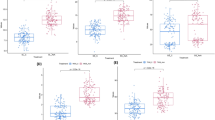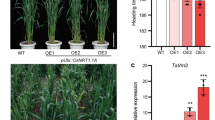Abstract
Salinity and drought are important abiotic stresses limiting plant growth and development. Late embryogenesis abundant (LEA) proteins are a group of proteins associated with tolerance to water-related stress. We previously cloned an LEA gene, SmLEA, from Salvia miltiorrhiza Bunge. Phylogenetic analysis indicated that SmLEA belongs to Group LEA14, which is involved in the dehydration response. To determine its function in detail, we have now overexpressed SmLEA in Escherichia coli and S. miltiorrhiza. The logarithmic increase in accumulations of SmLEA proteins in E. coli occurred earlier under salinity than under standard conditions. SmLEA-transformed S. miltiorrhiza plants also showed faster root elongation and a lower malondialdehyde concentration than the empty vector control plants did when cultured on MS media supplemented with 60 mM NaCl or 150 mM mannitol. Moreover, SmLEA-overexpressing transgenics experienced a less rapid rate of water loss. Under either salinity or drought, overexpressing plants had greater superoxide dismutase activity and a higher glutathione concentration. These results suggest that SmLEA may be useful in efforts to improve drought and salinity tolerance in S. miltiorrhiza. Our data also provide a good foundation for further studies into the stress resistance mechanism and molecular breeding of this valuable medicinal plant.





Similar content being viewed by others
References
Asada K (2000) The water-water cycle as alternative photon and electron sinks. Phil Trans Roy Soc Lond B 355:1419–1431. doi:10.1098/rstb.2000.0703
Babu RC, Zhang J, Blum A, Ho T, Wu R, Nguyen HT (2004) HVA1, a LEA gene from barley, confers dehydration tolerance in transgenic rice (Oryza sativa L.) via cell membrane protection. Plant Sci 166:855–862. doi:10.1016/j.plantsci.2003.11.023
Bray EA, Bailey-Serres J, Weretilnyk E (2000) Responses to abiotic stresses. In: Buchanan B, Gruissem W, Jones R. (eds.), Biochemistry and molecular biology of plants. American Society of Plant Physiologists, pp. 1158–1176
Ceccardi TL, Meyer NC, Close TJ (1994) Purification of a maize dehydrin. Protein Express Purif 5:266–269. doi:10.1006/prep.1994.1040
Close TJ, Kortt AA, Chandler PM (1989) A cDNA-based comparison of dehydration-induced proteins (dehydrins) in barley and corn. Plant Mol Biol 13:95–108. doi:10.1007/BF00027338
Dalal M, Tayal D, Chinnusamy V, Bansal KC (2009) Abiotic stress and ABA-inducible Group 4 LEA from Brassica napus plays a key role in salt and drought tolerance. J Biotechnol 139(2):137–145. doi:10.1016/j.jbiotec.2008.09.014
Doyle JJ, Doyle JL (1987) A rapid DNA isolation procedure from small quantities of fresh leaf tissue. Phytochem Bull 19:11–15
Dure L III, Greenway SC, Galau GA (1981) Developmental biochemistry of cottonseed embryogenesis and germination: changing messenger ribonucleic acid populations as shown by in vitro and in vivo protein synthesis. Biochemistry 20(14):4162–4168. doi:10.1021/bi00517a033
Galau GA, Wang HYC, Hughes DW (1993) Cotton Lea5 and Lea14 encode atypical late embryogenesis-abundant proteins. Plant Physiol 101:695–696
Han LM, Yu JN, Ju WF (2007) Salt and drought tolerance of transgenic Salvia miltiorrhiza Bunge with the TaLEA1 gene. J Plant Physiol Mol Biol 33(2):109–114
Iturriaga G, Schneider K, Salamini F, Bartels D (1992) Expression of desiccation-related proteins from the resurrection plant Craterostigma plantagineumin transgenic tobacco. Plant Mol Biol 20:555–558. doi:10.1007/BF00040614
Kim HS, Lee JH, Kim JJ, Kim CH, Jun SS, Hong YN (2005) Molecular and functional characterization of CaLEA6, the gene for a hydrophobic LEA protein from Capsicum annuum. Gene 344:115–123. doi:10.1016/j.gene.2004.09.012
Kyte J, Doolittle RF (1982) A simple method for displaying the hydropathic character of a protein. J Mol Biol 157:105–132. doi:10.1016/0022-2836(82)90515-0
Liu CL, Wang ZZ (2009) Cloning and expression analysis of SmLEA from Salvia miltiorrhiza Bunge. Biotechnol Bull 5:80–84
Liu CL, Wang ZZ (2010) Gene expression analysis of a late embryogenesis abundant gene from Salvia miltiorrhiza Bunge. China Biotechnol 30(1):51–55
Liu Y, Zheng Y (2005) PM2, a group 3 LEA protein from soybean, and its 22-mer repeating region confer salt tolerance in Escherichia coli. Biochem Biophys Res Comm 331(1):325–332. doi:10.1016/j.bbrc.2005.03.165
Li YC, Bao YM, Jiang B, Wang Z, Liu YX, Zhang C, An LJ (2008) Catalpol protects primary cultured astrocytes from in vitro ischemia-induced damage. Int J Dev Neurosci 26:309–317. doi:10.1016/j.ijdevneu.2008.01.006
Mahajan S, Tuteja N (2005) Cold, salinity and drought stresses: an overview. Arch Biochem Biophys 444:139–158. doi:10.1016/j.abb.2005.10.018
Maitra N, Cushman JC (1994) Isolation and characterization of a drought induced soybean cDNA encoding a D95 family late-embryogenesis abundant protein. Plant Physiol 106(2):805–806
Mohamed MA, Harris PJ, Henderson J (2000) In vitro selection and characterisation of a drought tolerant clone of Tagetes minuta. Plant Sci 159:213–222. doi:10.1016/S0168-9452(00)00339-3
Munns R (2005) Genes and salt tolerance: bringing them together. New Phytol 167:645–663. doi:10.1111/j.1469-8137.2005.01487.x
Noctor GH, Foyer C (1998) Ascorbate and glutathione: keeping active oxygen under control. Annu Rev Plant Physiol Plant Mol Biol 49:249–279. doi:10.1146/annurev.arplant.49.1.249
Park JA, Cho SK, Kim JE et al (2003) Isolation of cDNAs differentially expressed in response to drought stress and characterization of the Ca-LEAL1 gene encoding a new family of atypical LEA-like protein homologue in hot pepper (Capsicum annuum L. cv. Pukang). Plant Sci 165(3):471–481. doi:10.1016/S0168-9452(03)00165-1
Park SC, Kim CY, Lee HS, Bang JW, Kwak SS (2011) Sweetpotato late embryogenesis abundant 14 (IbLEA14) gene influences lignification and increases osmotic- and salt-stress tolerance of transgenic calli. Planta 233:621–634. doi:10.1007/s00425-010-1326-3
Sambrook J, Russell DW (2001) Molecular cloning: a laboratory manual, 3rd edn. Cold Spring Harbor Laboratory Press, New York
Sivamani E, Bahieldin A, Wraith JM, Al-Niemi T, Dyer WE, Ho T, Qu R (2000) Improved biomass productivity and water use efficiency under water deficit conditions in transgenic wheat constitutively expressing the barley HVA1 gene. Plant Sci 155:1–9. doi:10.1016/S0168-9452(99)00247-2
Slama I, Ghnaya T, Hessini K, Messedi D, Savoure A, Abdelly C (2007) Comparative study of the effects of mannitol and PEG osmotic stress on growth and solute accumulation in Sesuvium portulacastrum. Environ Exp Bot 61:10–17. doi:10.1016/j.envexpbot.2007.02.004
Soulages JL, Kim KM, Walters C, Cushman JC (2002) Temperature-induced extended helix/random coil transitions in a group 1 late embryogenesis-abundant protein from soybean. Plant Physiol 128:822–832. doi:10.1104/pp. 010521
Taylor NL, Tan YF, Jacoby RP, Millar AH (2009) Abiotic environmental stress induced changes in the Arabidopsis thaliana chloroplast, mitochondria and peroxisome proteomes. J Proteom 72(3):367–378. doi:10.1016/j.jprot.2008.11.006
Tunnacliffe A, Wise MJ (2007) The continuing conundrum of the LEA proteins. Naturwissenschaften 9:791–812. doi:10.1007/s00114-007-0254-y
Vandesompele J, de Preter K, Pattyn F et al (2002) Accurate normalization of real-time quantitative RT-PCR data by geometric averaging of multiple internal control genes. Genome Biol 3(7):RESEARCH0034
Wang DH, Yao W, Yin S, Liu WC, Wang ZZ (2012) Molecular characterization and expression of three galactinol synthase genes that confer stress tolerance in Salvia miltiorrhiza. J Plant Physiol 169:1838–1848. doi:10.1016/j.jplph.2012.07.015
Wang Y, Gao C, Liang Y, Wang C, Yang C, Liu G (2010) A novel bZIP gene from Tamarix hispida mediates physiological responses to salt stress in tobacco plants. J Plant Physiol 167:222–230. doi:10.1016/j.jplph.2009.09.008
Wise MJ (2003) LEAping to conclusions: a computational reanalysis of late embryogenesis abundant proteins and their possible roles. BMC Bioinform 4:52–70. doi:10.1186/1471-2105-4-52
Xu D, Duan X, Wang B, Hong B, Ho T, Wu R (1996) Expression of a late embryogenesis abundant protein gene, HVA1, from barley confers tolerance to water deficit and salt stress in transgenic rice. Plant Physiol 110:249–257
Yan Y, Wang Z (2007) Genetic transformation of the medicinal plant Salvia miltiorrhiza by Agrobacterium tumefaciens-mediated method. Plant Cell Tiss Org Cult 88:175–184. doi:10.1007/s11240-006-9187-y
Zhang L, Ohta A, Takagi M, Imai R (2000) Expression of plant group 2 and group 3 lea genes in Saccharomyces cerevisiae revealed functional divergence among LEA protein. J Biochem 127:611–616
Zegzouti H, Jones B, Marty C et al (1997) ER5, a tomato cDNA encoding an ethylene-responsive LEA like protein: characterization and expression in response to drought, ABA and wounding. Plant Mol Biol 35(6):847–854. doi:10.1023/A:1005860302313
Acknowledgments
This work benefited from financial support from the Natural Science Foundation of Shaanxi Province, China (2012JQ4013) and the National Natural Science Foundation of China (Grant No. 31300256).
Conflict of interest
The authors declare that they have no conflict of interest.
Author information
Authors and Affiliations
Corresponding author
Additional information
Handling Editor: Peter Nick
Electronic supplementary material
Below is the link to the electronic supplementary material.
ESM 1
(DOC 552 kb)
Rights and permissions
About this article
Cite this article
Wu, Y., Liu, C., Kuang, J. et al. Overexpression of SmLEA enhances salt and drought tolerance in Escherichia coli and Salvia miltiorrhiza . Protoplasma 251, 1191–1199 (2014). https://doi.org/10.1007/s00709-014-0626-z
Received:
Accepted:
Published:
Issue Date:
DOI: https://doi.org/10.1007/s00709-014-0626-z




